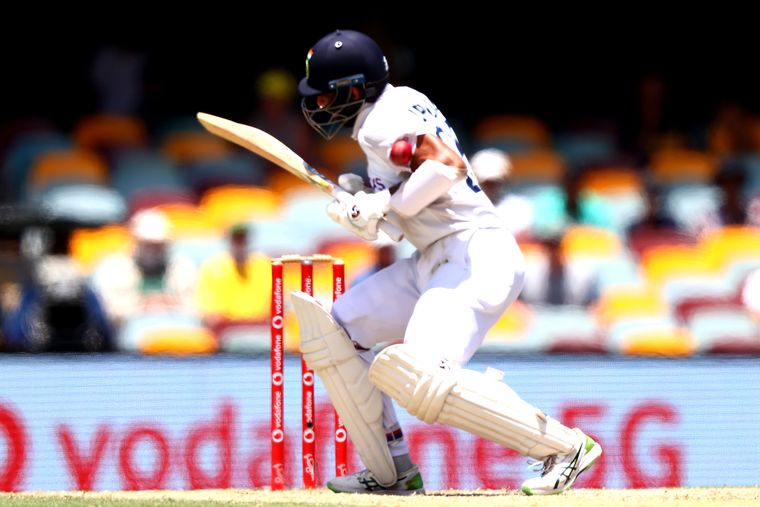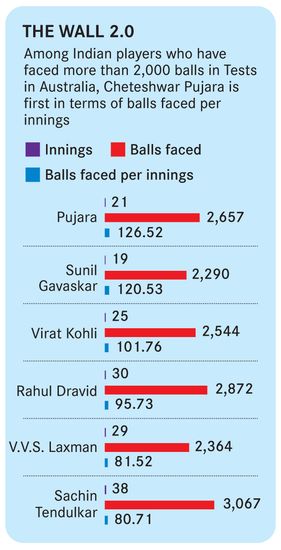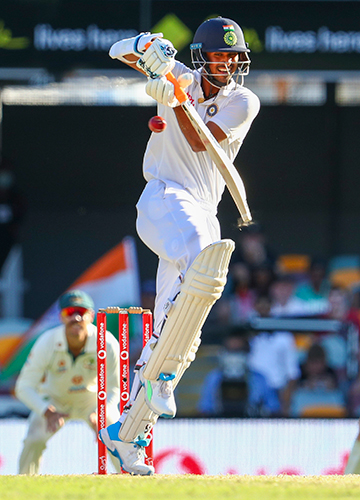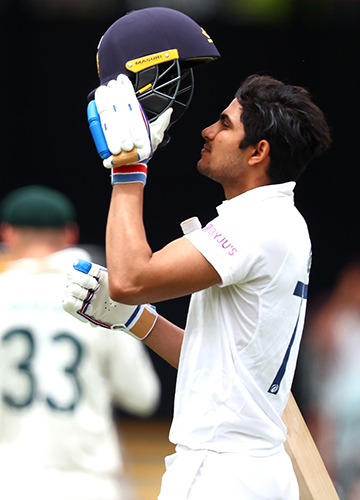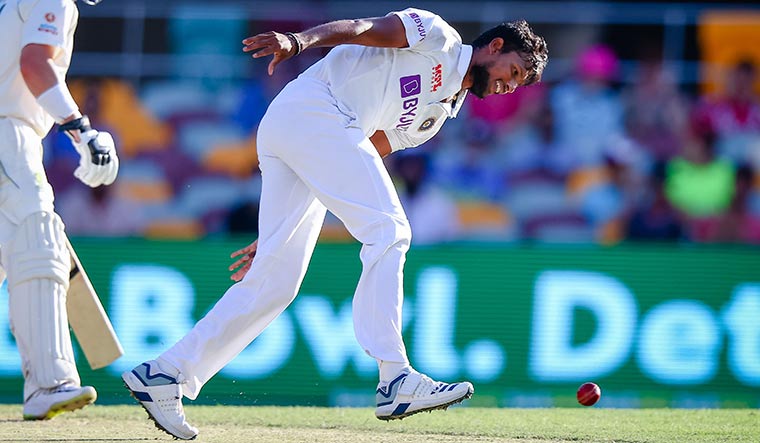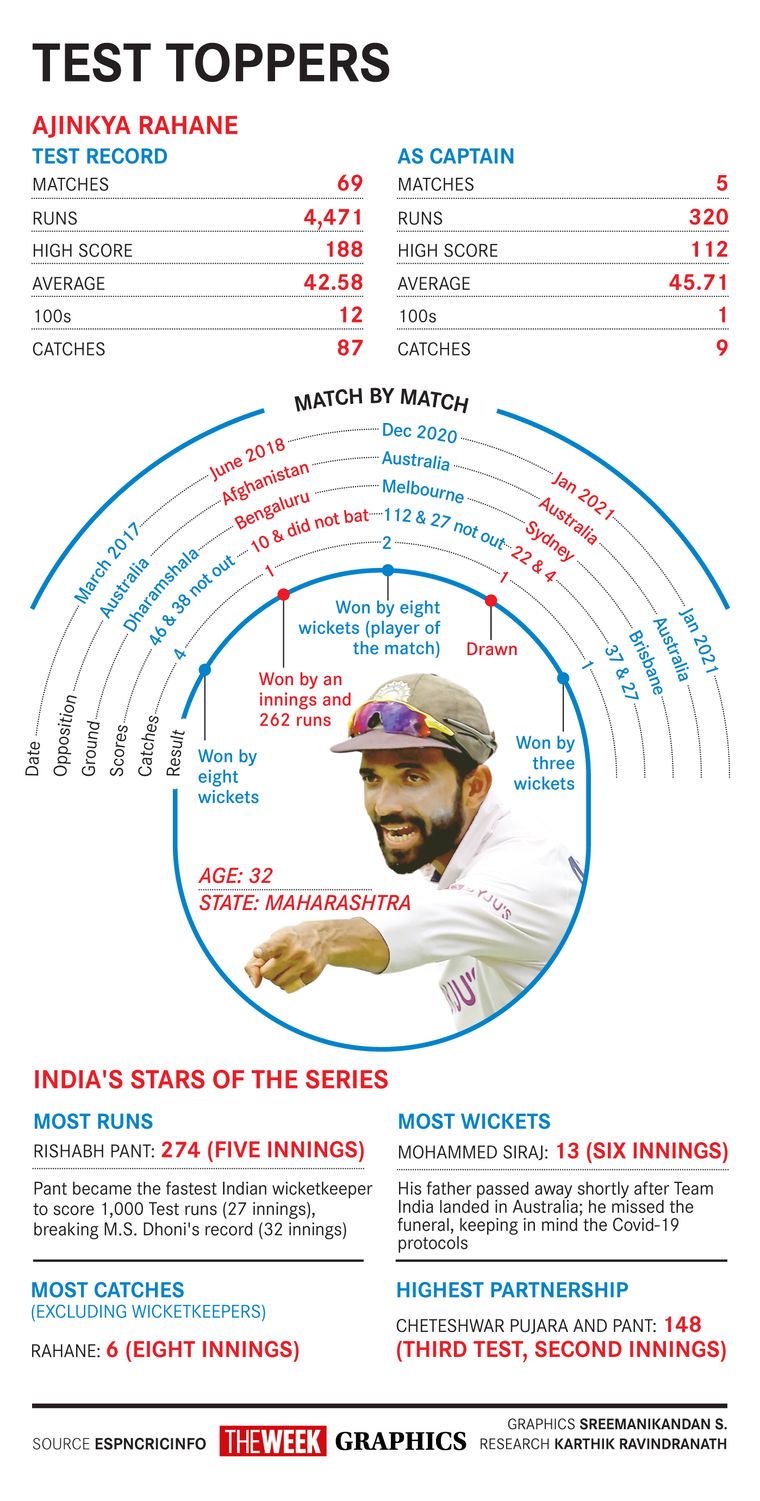You need to enjoy this moment, don’t let it go away. Just enjoy! The courage, resolve, spirit you have shown is... unreal. I have tears in my eyes.” This was Ravi Shastri, chief coach of the Indian cricket team, talking to his wards following the victory lap, the award ceremony and the mandatory television interviews. The Border-Gavaskar trophy was back in the Indian dressing room after India beat Australia 2-1 in the four-match series. There was no jumping or yelling; just exhausted faces with tired smiles. The feeling of having played a role in one of India’s greatest ever Test series wins was yet to sink in. Suddenly, those hellish five months in a bio-bubble, away from their families, felt worth it.
Rishabh Pant—the hero of day five in Brisbane—grinned wryly as Shastri told him, “You were simply outstanding! While you were batting, you gave us heart attacks every moment, but what you have done is amazing!” Pant rubbed his eyes and looked down.
For a player who was under scrutiny for his glove work throughout the series, Pant also got high praise from Sachin Tendulkar. “He is a threatening player and the Australians were worried. They were restless when Rishabh was around,” Tendulkar said on his app, 100MB.
The fairy tale tour of hard knocks came to an end with India slaying Australia at their fortress—the Gabba. Some even call it the Gabbatoir, for it is a place sacrificial touring teams are taken for slaughter. Australia had not lost a Test there since 1988. That is, till January 19, 2021. India beat the Aussies by three wickets, ending a 31-Test winning streak.
Sure, India had won the series the last time they toured Australia, in 2018-19, but this win surpasses that by a lot. Not only does this rank alongside India’s greatest Test achievements—the 1971 series win in England, the historic chase of 406 at Port of Spain in 1976, and the home series win against a rampaging Australia in 2001—this was also a series that threw up unlikely, unknown heroes. It was a month-long advertisement for Test cricket.
Tendulkar considered this India’s best Test series win ever. “Every time there was a blow, somebody stood tall and competed hard,” he said. “They were bruised and battered, but nobody gave up. It was incredible. [Have to] credit the team management—Ravi, Ajinkya [Rahane]. This is without any doubt the top series India has ever played. I don’t remember any series victory where there were so many injuries; in spite of this, we won.”
Former Australia coach John Buchanan told THE WEEK: “[It was] an epic result and an enthralling series, one which should help emphasise that to produce a Test series of this calibre, Test cricket must be five days, and must not be, for the most part, played under lights with a pink ball.”
His counterpart John Wright, who was coach of the Indian team that beat Australia in 2000-01 and drew with them in 2003-04, told THE WEEK: “Every true cricket fan anywhere must have celebrated the victory. It was such a boost for the five-day game. Heroic in every respect. It was a master stroke to play five bowlers. It was a true team effort; one only has to look at the batting card of India’s first innings. This may well not be the team that takes the field for India’s next Test, but it deserves to be. Wonderful!”
Shastri described the series win as “unreal” and the “toughest tour” he had seen. Speaking after the victory, he said, “To be in a lockdown for four months, [then] go to the IPL in a bio-bubble… Jasprit Bumrah was the only bowler in the squad to have bowled 64 overs [in Australia]. None of the others had bowled as many going into [this] series. Then coming to Australia, being in quarantine, getting bowled out for 36 in the first Test and then coming back and playing like champions. The penny has still not dropped. It is unimaginable, unreal and simply superb.”
Buchanan admitted that he believed it was advantage Australia from the outset. “With Kohli leaving after the first Test, Ishant [Sharma] and Rohit [Sharma] not touring (there was doubt about their inclusion), I believed it would be difficult for India to draw the series, let alone win it,” he said.
Analysing where India had outthought and outplayed the hosts, he said, “Australia won three tosses, so it was their batsmen who were responsible for making first and second innings totals that were both large enough and quick enough to place India under huge pressure to defend in the fourth innings. Australia looked like they were in this position in Sydney (third Test), but crucial fielding errors made it difficult to force the result.
“The vigil of [Ravichandran] Ashwin and Hanuma Vihari for some 43 overs [was] a series-turning effort; however, this was on the back of a very defiant top order and an aggressive Pant. More injuries to India’s bowling line-up for the fourth Test definitely favoured Australia. But as both teams found out, India to their liking and Australia to their frustration, the Gabba wicket had been tamed by this time of year. It was not the hostile November, first Test wicket that visiting teams have come to dread (touring teams usually play at the Gabba first). The so-called ‘second string’ Indian bowling attack relished the Gabba and once again contained the batting line-up in both innings. India found a way to not only survive the final day, but also to score the 328 runs needed for victory.”
As Pant carried the tricolour along with his teammates during the victory lap, the members of the support staff walked beside them. They deserved the lap, too. With a jumbo squad to take care of and a slew of injuries to key players throughout the tour, their workload had increased dramatically. Shastri thanked each member of the support staff individually in the dressing room after the last Test. The team of Shastri, batting coach Vikram Rathour, bowling coach Bharat Arun, fielding coach R. Sridhar, team physiologist Dr Nitin Patel, masseurs Arun Kanade and Rajiv Kumar, conditioning coach Soham Desai, trainer Nick Webb and throw-down specialists Nuwan and Raghu, had lifted the body, mind and spirits of the players, especially after the Adelaide hiding and the pile of injuries.
And what about the stand-in captain, Ajinkya Rahane? It was an unenviable task, especially after Adelaide. But Rahane epitomises the word khadoos, which refers to the doggedness of Mumbai and its cricketers. Though not aggressive by way of expression, he did use aggression in his strategies. Rahane had earlier used his cricketing nous to defeat Australia in Dharamshala in 2017, but this was a different kettle of fish.
Shastri, who has a fantastic rapport with the expressive and aggressive Kohli, described Rahane thus: “[He was] calm and composed, not ruffled by anything. He was taking everything in his stride.”
In the tense closing moments at the Gabba, Rahane sat with his deputy Rohit Sharma, his face revealing little. When the match was won, he asked Pant to lead the victory lap. “It was really tough,” he said after the match. “It was all about character, [we were] not thinking too much. Credit to each individual, it was a team effort.”
At the individual level, Rahane’s 112 in Melbourne helped turn the tide India’s way. The team won and the series was 1-1. Predictably, the captain underplayed his efforts. “I looked good because everyone contributed,” he said.
His senior partner Cheteshwar Pujara was also, expectedly, a standout. While thanking him in the dressing room, Shastri said, “Puji, you will be known as the ultimate warrior.” Pujara acknowledged it with a sweet smile and a raised hand. No other player had it as tough as him. The architect of the 2018-19 series victory (he scored more than 500 runs and batted for hours), could manage only 271 runs and three half centuries this time. But, he faced 928 balls. Said Tendulkar: “People keep talking about his strike rate, not being able to rotate strike; I would tell Pujara [to] ignore those guys! They are not at the same level as you are. I hold him in extremely high regard, [he is a] world-class player.”
Said Buchanan: “Australia looked like they had Pujara’s measure after the first two Tests, but then he proceeded to score 50 (176) and 77 (205) in Sydney to lay the benchmark for an incredible draw. He followed this with 25 (94) and a heroic 56 (211) in Brisbane to be the rock around which Pant and the others were able to craft victory.”
Pujara protected the young guns; he took the blows and ground down the bowlers so that his junior partners could play freely. In Brisbane, he was hit 11 times as Pat Cummins and company peppered him with short balls and bowled into his body. “Nasty,” said Australian legend Shane Warne on air.
The series, perhaps above all else, will be remembered for the exploits of the newcomers—Shubman Gill, Mohammed Siraj, Shardul Thakur, T. Natarajan and Washington Sundar. They got their chances because of the injured players and, in Gill’s case, because of Prithvi Shaw’s poor form.
From his maiden Test innings, Gill looked the part. He became the second highest run scorer for India in the series, scoring 259 runs in three matches. His 91 in the second innings at the Gabba laid the platform for India to chase boldly. “He batted exceptionally well,” said Tendulkar. “He looked very compact and he was opportunistic—whenever he found the chance, he scored a boundary.”
Another young man who made the most of his opportunity was Sundar. The 21-year-old off-spinner, known for his performances in the IPL and the Tamil Nadu Premier League, last played a First-Class match three years ago! He was told of his inclusion in the side only two days ahead of the Gabba Test. Not only did he bowl with discipline, taking 3/89 and 1/80 in the two innings, he also shone with the bat. He batted with Shardul Thakur for 36 overs to score 62, thwarting Australia’s plans to mop up the tail, and played a quick cameo of 22 in the second innings to take India close to the target.
Thakur himself scored a fighting 67 and took seven wickets in the match. His bowling partner Siraj got his first five-wicket haul in the second innings. It was an emotional moment.
And then there was Thangarasu Natarajan. He was taken to Australia as a net bowler, but ‘Nattu’ got a dream opportunity after others fell to injuries. He picked up three wickets in the first innings, including that of Marnus Labuschagne. Hailing from a poor background, he was spotted playing tennis ball cricket in the dusty fields of Chinnappampatti in Tamil Nadu’s Salem district. He played with a cricket ball for the first time in 2010, when district cricket officials spotted and drafted him in the district league.
Years later, the IPL brought in hefty pay cheques and the Gabba gave him his dream. However, the immediate future is certain. The selectors have not picked him for the upcoming home series against England. Yet, he remains stoic. “He did not look out of place in the Test. He knew what he was doing. There was maturity there,” said Tendulkar.
The Indian bench strength is no accident. There has been careful planning and monitoring by the BCCI and former India A coach and head of the National Cricket Academy Rahul Dravid. Since 2010, India A have played 52 First-Class matches, the most by any team. Siraj has played 16 A-team matches, Navdeep Saini 14, Vihari 12, Mayank Agarwal 10, Gill eight, Shaw five and Pant four. They have toured South Africa, Australia, the West Indies and New Zealand. They were thrown into the deep end in this series, but they knew how to swim. Australia head coach Justin Langer, his shoulders dropping in resignation, said: “Never ever underestimate the Indians. To have 1.5 billion people… if you play in the XI, you have got to be really tough.”



